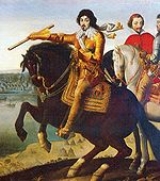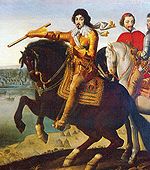
Antoine de Pluvinel
Encyclopedia
Antoine de Pluvinel was the first of the French riding masters, and has had great influence on modern dressage
. He wrote L’Instruction du Roy en l’exercice de monter à cheval ("instruction of the King in the art of riding"), was tutor to King Louis XIII, and is credited with the invention of using two pillars, as well as using shoulder-in to increase suppleness.
 Antoine de Pluvinel was born in the town of Crest, then in the province of the Dauphiné
Antoine de Pluvinel was born in the town of Crest, then in the province of the Dauphiné
in France. His date of birth is given as 1552 by Terrebasse, where it is based on the Mémoire of Pluvinel's son-in-law. It is given as 1555 by several other authors including Saurel, Christian, Mennessier, and Monteilhet, which according to Tucker does not coincide with other known details of his life. Antoine de Pluvinel left for Italy at the age of 10 or seventeen to begin studying horsemanship under Giovanni Battista Pignatelli
, and trained under him until 1571 or 1572. He then returned to France to study under M. de Sourdis, before becoming the premier ecuyer to the Duc d'Anjou (who would later become Henri III) and accompanying him to his new throne in Poland. After the death of King Charles IX
, Henri returned to France, taking Pluvinel with him.
He gave several honors to Pluvinel, continued by his brother-in-law, Henri IV, from 1589, including chamberlain, tutor to the Duc de Vendôme, governor of Grosse Tour de Bourges, and sub-governor to the dauphin Louis (the future Louis XIII) to whom he taught horse-riding. The diary of Jean Héroard (main witness of the childhood of Louis XIII) describes the relationships between the King and his sub-governor.
In 1594, Pluvinel founded the "Academie d'Equitation" near what is now Place des Pyramides
, a long-time dream. There, the French nobility was trained not only in horsmanship, but also in all the accomplishments (dancing, fashionable dressing, etc.) It can be said that Pluvinel's influence on the aristocracy lasted from the late 16th century to the 17th century. Richelieu, the future Prime minister of King Louis XIII attended the Academie; so did William, duke of Cavendish.
Pluvinel died on 24 August 1620, leaving no male heir. His name passed on his nephews La Baume, who were authorized to add Pluvinel to their own name and later became marquesses of la Baume de Pluvinel (1693).
Pluvinel's book was published posthumously by the Flemish engraver Crispijn van de Passe II and the royal valet de chambre
J.D. Peyrol, first in 1623 under the name "Le Maneige Royal", with magnificent engravings, but having never been edited. In 1625 the book was published in its complete form, having been edited by Pluvinel's friend Menou de Charnizay, under its definitive name "L'Instruction du Roy en l'exercice de monter à cheval" ("Instruction of the King in the exercise of horse riding"). It has since been re-printed several times, and translated into many languages.
 Pluvinel is perhaps most well-known for his kind, humane training methods. Unlike his Italian teacher Pignatelli
Pluvinel is perhaps most well-known for his kind, humane training methods. Unlike his Italian teacher Pignatelli
, who often used harsh methods to gain obedience from the horse, Pluvinel used praise, careful use of aids, and softer bits (simple curb
bits) to get the horse to work with him.
He is also credited with the use of the pillars (wrongly, for La Noue also has record of using them, as does the Greek Eumenes
), and he used them extensively in his training of collection and levade. Additionally, he employed the two-track movements, such as shoulder-in
, and volte
s to supple the horse.
His theories include that the horse must take pleasure in work, due to gentle, understanding riding, and that such a horse will move much more gracefully if he enjoys being ridden.
Dressage
Dressage is a competitive equestrian sport, defined by the International Equestrian Federation as "the highest expression of horse training." Competitions are held at all levels from amateur to the World Equestrian Games...
. He wrote L’Instruction du Roy en l’exercice de monter à cheval ("instruction of the King in the art of riding"), was tutor to King Louis XIII, and is credited with the invention of using two pillars, as well as using shoulder-in to increase suppleness.
History

Dauphiné
The Dauphiné or Dauphiné Viennois is a former province in southeastern France, whose area roughly corresponded to that of the present departments of :Isère, :Drôme, and :Hautes-Alpes....
in France. His date of birth is given as 1552 by Terrebasse, where it is based on the Mémoire of Pluvinel's son-in-law. It is given as 1555 by several other authors including Saurel, Christian, Mennessier, and Monteilhet, which according to Tucker does not coincide with other known details of his life. Antoine de Pluvinel left for Italy at the age of 10 or seventeen to begin studying horsemanship under Giovanni Battista Pignatelli
Giovanni Battista Pignatelli
Giovanni Battista Pignatelli was an early sixteenth-century Italian riding master who had influence on horse training and dressage during his time. Taught by Federico Grisone in Naples, Pignatelli inherited his mentor's cruel methods...
, and trained under him until 1571 or 1572. He then returned to France to study under M. de Sourdis, before becoming the premier ecuyer to the Duc d'Anjou (who would later become Henri III) and accompanying him to his new throne in Poland. After the death of King Charles IX
Charles IX of France
Charles IX was King of France, ruling from 1560 until his death. His reign was dominated by the Wars of Religion. He is best known as king at the time of the St. Bartholomew's Day Massacre.-Childhood:...
, Henri returned to France, taking Pluvinel with him.
He gave several honors to Pluvinel, continued by his brother-in-law, Henri IV, from 1589, including chamberlain, tutor to the Duc de Vendôme, governor of Grosse Tour de Bourges, and sub-governor to the dauphin Louis (the future Louis XIII) to whom he taught horse-riding. The diary of Jean Héroard (main witness of the childhood of Louis XIII) describes the relationships between the King and his sub-governor.
In 1594, Pluvinel founded the "Academie d'Equitation" near what is now Place des Pyramides
Place des Pyramides
Place des Pyramides is a public square in the 1st arrondissement of Paris, France. It is located in the middle of the Rue de Rivoli, at its intersection with the Rue des Pyramides and Avenue du General Lemonnier, at the western end of the Tuileries Garden....
, a long-time dream. There, the French nobility was trained not only in horsmanship, but also in all the accomplishments (dancing, fashionable dressing, etc.) It can be said that Pluvinel's influence on the aristocracy lasted from the late 16th century to the 17th century. Richelieu, the future Prime minister of King Louis XIII attended the Academie; so did William, duke of Cavendish.
Pluvinel died on 24 August 1620, leaving no male heir. His name passed on his nephews La Baume, who were authorized to add Pluvinel to their own name and later became marquesses of la Baume de Pluvinel (1693).
Pluvinel's book was published posthumously by the Flemish engraver Crispijn van de Passe II and the royal valet de chambre
Valet de chambre
Valet de chambre , or varlet de chambre, was a court appointment introduced in the late Middle Ages, common from the 14th century onwards. Royal Households had many persons appointed at any time...
J.D. Peyrol, first in 1623 under the name "Le Maneige Royal", with magnificent engravings, but having never been edited. In 1625 the book was published in its complete form, having been edited by Pluvinel's friend Menou de Charnizay, under its definitive name "L'Instruction du Roy en l'exercice de monter à cheval" ("Instruction of the King in the exercise of horse riding"). It has since been re-printed several times, and translated into many languages.
Riding theories

Giovanni Battista Pignatelli
Giovanni Battista Pignatelli was an early sixteenth-century Italian riding master who had influence on horse training and dressage during his time. Taught by Federico Grisone in Naples, Pignatelli inherited his mentor's cruel methods...
, who often used harsh methods to gain obedience from the horse, Pluvinel used praise, careful use of aids, and softer bits (simple curb
Curb bit
A curb bit is a type of bit used for riding horses that uses lever action. It includes the pelham bit and the Weymouth curb along with the traditional "curb bit" used mainly by Western riders....
bits) to get the horse to work with him.
He is also credited with the use of the pillars (wrongly, for La Noue also has record of using them, as does the Greek Eumenes
Eumenes
Eumenes of Cardia was a Thracian general and scholar. He participated in the wars of the Diadochi as a supporter of the Macedonian Argead royal house.-Career:...
), and he used them extensively in his training of collection and levade. Additionally, he employed the two-track movements, such as shoulder-in
Shoulder-in
The shoulder-in is a lateral movement in dressage used to supple and balance the horse and encourage use of its hindquarters. It is performed on three tracks, where the horse is bent around the rider's inside leg so that the horse's inside hind leg and outside foreleg travel on the same line...
, and volte
Volte
The volte is a very small circle that is used in the training of a horse. Of all the circles, it requires the most balance from the horse. Voltes are excellent training tools, encouraging engagement and power.-Size of the volte:...
s to supple the horse.
His theories include that the horse must take pleasure in work, due to gentle, understanding riding, and that such a horse will move much more gracefully if he enjoys being ridden.
Published works
- Maneige royal ou l'on peut remarquer le defaut et la perfection du chevalier, en tous les exercices de cet art, digne des princes, fait et pratiqué en l'instruction du Roy, par Antoine Pluvinel, son escuyer principal ... Le tout gravé et représenté en grandes figures de taille-douce par Crispian de Pas ... Paris: Guillaume le Noir et Melchior Tavernier, 1623
- L'Instruction du Roy en l'exercice de monter à cheval, par messire Antoine de Pluvinel,... Enrichy de grandes figures en taille-douce... desseignées et gravées par Crispian de Pas le jeune Paris: Michel Nivelle, 1625

